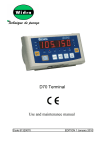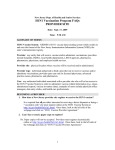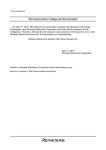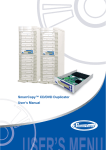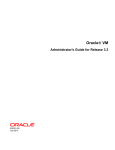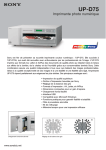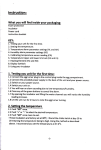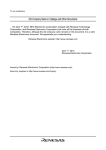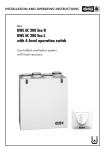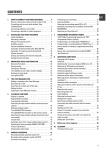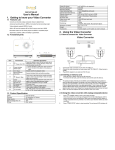Download PB-TIM2 User`s Manual Preface PB-TIM2
Transcript
PB-TIM2 User’s Manual Preface PB-TIM2 General Purpose 16+8 bit Timer Piggyback Order No. 14257 User’s Manual Issue 1 Preliminary Unpacking and Special Handling Instructions This PepCard product is carefully designed for a long and fault-free life; nonetheless, its life expectancy can be drastically reduced by improper treatment during unpacking and installation. Observe standard anti-static precautions when changing piggybacks, ROM devices, jumper settings, etc. If the product contains batteries for RTC or memory back-up, ensure that the board is not placed on conductive surfaces, including anti-static plastics or sponges. These can cause shorts and damage to the batteries or tracks on the board. When installing the board, switch off the power mains to the chassis. Do not disconnect the mains as the ground connection prevents the chassis from static voltages, which can damage the board as it is inserted. Furthermore, do not exceed the specified operational temperature ranges of the board version ordered. If batteries are present, their temperature restrictions must be taken into account. Keep all the original packaging material for future storage or warranty shipments. If it is necessary to store or ship the board, re-pack it as it was originally packed. July 30, 1997 © 1996 PEP Modular Computer Page 0-1 Preface PB-TIM2 User’s Manual R EVISION HISTORY Revision History Manual/Product Title PB-TIM2 Publication Number 14257 Issue 1 Brief Description of Changes Rev. First release of Issue 1 manual 1 Date of issue 19th Mar. 1996 Date of issue = the release date of the issue. This date does not necessarily reflect the date the improvements were first made. This document contains proprietary information of PEP Modular Computers. It may not be copied or transmitted by any means, passed to others, or stored in any retrieval system or media, without the prior consent of PEP Modular Computers or its authorized agents. The information in this document is, to the best of our knowledge, entirely correct. However, PEP Modular Computers cannot accept liability for any inaccuracies, or the consequences thereof, nor for any liability arising from the use or application of any circuit, product, or example shown in this document. PEP Modular Computers reserve the right to change, modify, or improve this document or the product described herein, as seen fit by PEP Modular Computers without further notice. Page 0-2 © 1996 PEP Modular Computers July 30, 1997 PB-TIM2 User’s Manual Preface PEP Modular Computers® Two Year Limited Warranty We grant the original purchaser of PEP products the following hardware warranty. No other warranties that may be granted or implied by anyone on behalf of PEP are valid unless the consumer has the express written consent of PEP Modular Computers. PEP Modular Computers warrants their own products (excluding software) to be free from defects in workmanship and materials for a period of 24 consecutive months from the date of purchase. This warranty is not transferable nor extendible to cover any other consumers or long term storage of the product. This warranty does not cover products which have been modified, altered, or repaired by any other party than PEP Modular Computers or their authorized agents. Furthermore, any product which has been, or is suspected of being damaged as a result of negligence, misuse, incorrect handling, servicing or maintenance; or has been damaged as a result of excessive current/voltage or temperature; or has had its serial number(s), any other markings, or parts thereof altered, defaced, or removed will also be excluded from this warranty. A customer who has not excluded his eligibility for this warranty may, in the event of any claim, return the product at the earliest possible convenience, together with a copy of the original proof of purchase, a full description of the application it is used on, and a description of the defect; to the original place of purchase. Pack the product in such a way as to ensure safe transportation (we recommend the original packing materials), whereby PEP undertakes to repair or replace any part, assembly or sub-assembly at our discretion; or, to refund the original cost of purchase, if appropriate. In the event of repair, refund, or replacement of any part, the ownership of the removed or replaced parts reverts to PEP Modular Computers, and the remaining part of the original guarantee, or any new guarantee to cover the repaired or replaced items, will be transferred to cover the new or repaired items. Any extensions to the original guarantee are considered gestures of goodwill, and will be defined in the "Repair Report" returned from PEP with the repaired or replaced item. Other than the repair, replacement, or refund specified above, PEP Modular Computers will not accept any liability for any further claims which result directly or indirectly from any warranty claim. We specifically exclude any claim for damage to any system or process in which the product was employed, or any loss incurred as a result of the product not functioning at any given time. The extent of PEP Modular Computers liability to the customer shall not be greater than the original purchase price of the item for which any claim exists. PEP Modular Computers makes no warranty or representation, either express or implied, with respect to its products, reliability, fitness, quality, marketability or ability to fulfill any particular application or purpose. As a result, the products are sold "as is," and the responsibility to ensure their suitability for any given task remains the purchaser's. In no event will PEP be liable for direct, indirect, or consequential damages resulting from the use of our hardware or software products, or documentation; even if we were advised of the possibility of such claims prior to the purchase of, or during any period since the purchase of the product. Please remember that no PEP Modular Computers employee, dealer, or agent are authorized to make any modification or addition to the above terms, either verbally or in any other form written or electronically transmitted, without consent. July 30, 1997 © 1996 PEP Modular Computer Page 0-3 Preface PB-TIM2 User’s Manual T ABLE OF CONTENTS Chapter/Section/Sub-section Page 1. Introduction . . . . . . . . . . . . . . . . . . . . . . . . . . . . . . . . . . . . . . . . . . . . . . . . . . . . . . . . . . . 1.1 Product Overview . . . . . . . . . . . . . . . . . . . . . . . . . . . . . . . . . . . . . . . . . . . . . . . . . 1.2 Ordering Information . . . . . . . . . . . . . . . . . . . . . . . . . . . . . . . . . . . . . . . . . . . . . . . 1.3 Specifications . . . . . . . . . . . . . . . . . . . . . . . . . . . . . . . . . . . . . . . . . . . . . . . . . . . . 1.4 Board Overview . . . . . . . . . . . . . . . . . . . . . . . . . . . . . . . . . . . . . . . . . . . . . . . . . . . 1.5 Features . . . . . . . . . . . . . . . . . . . . . . . . . . . . . . . . . . . . . . . . . . . . . . . . . . . . . . . . . . . . . . 1-1 1-1 1-1 1-2 1-3 1-3 2. Functional Description . . . . . . . . . . . . . . . . . . . . . . . . . . . . . . . . . . . . . . . . . . . . . . . . . . . . . . . . . . 2.1 Normal Timer Mode . . . . . . . . . . . . . . . . . . . . . . . . . . . . . . . . . . . . . . . . . . . . . . . . . . . . . 2.2 Board Operation . . . . . . . . . . . . . . . . . . . . . . . . . . . . . . . . . . . . . . . . . . . . . . . . . . . . . . . . 2.3 Timer Operating Modes . . . . . . . . . . . . . . . . . . . . . . . . . . . . . . . . . . . . . . . . . . . . . . . . . . . 2.3.1 Hardware Single Shot (Retrigerable) . . . . . . . . . . . . . . . . . . . . . . . . . . . . . . . . . . . . . . . 2.3.2 Hardware Single Shot . . . . . . . . . . . . . . . . . . . . . . . . . . . . . . . . . . . . . . . . . . . . . . . . 2.3.3 TIC Generation . . . . . . . . . . . . . . . . . . . . . . . . . . . . . . . . . . . . . . . . . . . . . . . . . . . . 2.3.4 Period Measurement . . . . . . . . . . . . . . . . . . . . . . . . . . . . . . . . . . . . . . . . . . . . . . . . . 2.3.5 Frequency Measurement . . . . . . . . . . . . . . . . . . . . . . . . . . . . . . . . . . . . . . . . . . . . . . . 2.3.6 Square Wave Generation . . . . . . . . . . . . . . . . . . . . . . . . . . . . . . . . . . . . . . . . . . . . . . . 2.3.7 PWM Generation . . . . . . . . . . . . . . . . . . . . . . . . . . . . . . . . . . . . . . . . . . . . . . . . . . . 2.3.8 Input Signal Edge Sampling . . . . . . . . . . . . . . . . . . . . . . . . . . . . . . . . . . . . . . . . . . . . 2.3.9 Event Signal Duration . . . . . . . . . . . . . . . . . . . . . . . . . . . . . . . . . . . . . . . . . . . . . . . . 2-1 2-2 2-3 2-3 2-4 2-4 2-4 2-5 2-5 2-5 2-5 2-5 2-5 3. Configuration . . . . . . . . . . . . . . . . . . . . . . . . . . . . . . . . . . . . . . . . . . . . . . . . . . . . . . . . . . . . . . . . 3.1 Board Overview . . . . . . . . . . . . . . . . . . . . . . . . . . . . . . . . . . . . . . . . . . . . . . . . . . . . . . . . . 3.1.1 Input Electrical Specification . . . . . . . . . . . . . . . . . . . . . . . . . . . . . . . . . . . . . . . . . . . 3.1.1.1 Input Voltage Selection . . . . . . . . . . . . . . . . . . . . . . . . . . . . . . . . . . . . . . . . . . 3.1.1.2 Input Frequency Response . . . . . . . . . . . . . . . . . . . . . . . . . . . . . . . . . . . . . . . . . 3.1.1.3 Input EMI Protection . . . . . . . . . . . . . . . . . . . . . . . . . . . . . . . . . . . . . . . . . . . . 3.1.2 Output Electrical Specification . . . . . . . . . . . . . . . . . . . . . . . . . . . . . . . . . . . . . . . . . . 3.1.3 MODPACK Timing Specifications . . . . . . . . . . . . . . . . . . . . . . . . . . . . . . . . . . . . . . . 3-1 3-1 3-2 3-2 3-3 3-3 3-4 3-4 4. Programming . . . . . . . . . . . . . . . . . . . . . . . . . . . . . . . . . . . . . . . . . . . . . . . . . . . . . . . . . . . . . . . . 4.1 VMEbus Interface . . . . . . . . . . . . . . . . . . . . . . . . . . . . . . . . . . . . . . . . . . . . . . . . . . . . . . . 4.1.1 PB-TIM2 Address Map . . . . . . . . . . . . . . . . . . . . . . . . . . . . . . . . . . . . . . . . . . . . . . . 4.2 Register Allocation . . . . . . . . . . . . . . . . . . . . . . . . . . . . . . . . . . . . . . . . . . . . . . . . . . . . . . 4.2.1 Channel Control Register . . . . . . . . . . . . . . . . . . . . . . . . . . . . . . . . . . . . . . . . . . . . . . 4.2.2 Channel Mode Register . . . . . . . . . . . . . . . . . . . . . . . . . . . . . . . . . . . . . . . . . . . . . . . 4.2.3 Channel Interrupt Pending Register . . . . . . . . . . . . . . . . . . . . . . . . . . . . . . . . . . . . . . . 4.2.4 Channel Interrupt Clear Register . . . . . . . . . . . . . . . . . . . . . . . . . . . . . . . . . . . . . . . . . 4.2.5 Channel Interrupt Authorization Register . . . . . . . . . . . . . . . . . . . . . . . . . . . . . . . . . . . 4.2.6 Prescaler Value . . . . . . . . . . . . . . . . . . . . . . . . . . . . . . . . . . . . . . . . . . . . . . . . . . . . . 4.2.7 Counter Value . . . . . . . . . . . . . . . . . . . . . . . . . . . . . . . . . . . . . . . . . . . . . . . . . . . . . 4.2.8 Comparator Value . . . . . . . . . . . . . . . . . . . . . . . . . . . . . . . . . . . . . . . . . . . . . . . . . . . 4.2.9 Common Control Register . . . . . . . . . . . . . . . . . . . . . . . . . . . . . . . . . . . . . . . . . . . . . 4.2.10 Common Interrupt Pending Register . . . . . . . . . . . . . . . . . . . . . . . . . . . . . . . . . . . . . . 4.2.11 Common Interrupt Authorization Register . . . . . . . . . . . . . . . . . . . . . . . . . . . . . . . . . . 4.2.12 Interrupt Vector . . . . . . . . . . . . . . . . . . . . . . . . . . . . . . . . . . . . . . . . . . . . . . . . . . . 4.2.13 Write EEPROM Access Register . . . . . . . . . . . . . . . . . . . . . . . . . . . . . . . . . . . . . . . . 4.2.14 Read EEPROM Access Register . . . . . . . . . . . . . . . . . . . . . . . . . . . . . . . . . . . . . . . . 4.2.15 Software ID Byte . . . . . . . . . . . . . . . . . . . . . . . . . . . . . . . . . . . . . . . . . . . . . . . . . . 4.2.16 Hardware ID Byte . . . . . . . . . . . . . . . . . . . . . . . . . . . . . . . . . . . . . . . . . . . . . . . . . . 4-1 4-1 4-1 4-2 4-2 4-2 4-3 4-4 4-4 4-4 4-5 4-5 4-6 4-6 4-7 4-7 4-8 4-8 4-8 4-9 Page 0-4 © 1996 PEP Modular Computers . . . . . . . . . . . . . . . . . . . . . . . . . . . . . . July 30, 1997 PB-TIM2 User’s Manual Preface 5. Pinouts . . . . . . . . . . . . . . . . . . . . . . . . . . . . . . . . 5.1 Main Board . . . . . . . . . . . . . . . . . . . . . . . 5.1.1 ST100 Connector . . . . . . . . . . . . . . . 5.1.2 ST101 Connector . . . . . . . . . . . . . . . 5.1.3 ST102 Connector . . . . . . . . . . . . . . . 5.1.4 ST102 VMOD-2(D)/IMOD Connection July 30, 1997 . . . . . . . . . . . . . . . . . . . . . . . . . . . . . . . . . . . . . . . . . . . . . . . . . . . . . . . . . . . . . . . . . . . . . . . . © 1996 PEP Modular Computer . . . . . . . . . . . . . . . . . . . . . . . . . . . . . . . . . . . . . . . . . . . . . . . . . . . . . . . . . . . . . . . . . . . . . . . . . . . . . . . . . . . . . . . . . . . . . . . . . . . . . . . . . . . . . . . . . . . . . . . . . . . . . . . . . . . . . . . . . . . . . . . . 5-1 5-1 5-2 5-2 5-3 5-4 Page 0-5 Preface PB-TIM2 User’s Manual This page has been left blank intentionally. Page 0-6 © 1996 PEP Modular Computers July 30, 1997 PB-TIM2 User’s Manual Chapter 1 Introduction 1 1. INTRODUCTION 1.1 Product Overview The PB-TIN2 is an optoisolated, general purpose timer piggyback for the VMOD-2 and CXM-IMOD range of PEP boards. Three independent timers with 16+8 bit resolution and possessing 9 modes of operation are galvanically isolated from the process. Three inputs and an output per counter may be software configured. 1.2 Ordering Information Product Description Order Nr. PB-TIM2 Modpack with 3 independently configurable timers possessing 3 optoisolated 24V DC filtered inputs and 1 optoisolated 24V DC, 200mA output per counter. 13745 PB-TIM2 Modpack with 3 independently configurable timers possessing 3 optoisolated 12V DC filtered inputs and 1 optoisolated 24V DC, 200mA output per counter. 13746 PB-TIM2 Modpack with 3 independently configurable timers possessing 3 optoisolated 5V DC filtered inputs and 1 optoisolated 24V DC, 200mA output per counter. 13747 July 30, 1997 © 1996 PEP Modular Computers Page 1-1 Chapter 1 Introduction PB-TIM2 User’s Manual 1.3 Specifications Timer 16-bit up/down synchronous counter 16-bit preset register 16-bit comparator 16-bit zero detection 16-bit last value latch 8-bit prescaler 1-bit toggle register Input Channels Trigger, gate and clear together with a common clear. All optoisolated and protected against reverse polarity Output Channels 1 digital output per counter, 24V DC @ 200mA with inductive load protection, high-side switch Input Voltage 5V, 12V(15V) or 24V Input Current 15mA typically Switching Level 2V, 7.4V or 18.6V respectively Input Frequency Up to 300 kHz, embedded filter Output Frequency Up to 10 kHz Isolation Voltages 1500V DC I/O to system, 100V DC between inputs Timer Clock 4 MHz (250 ns) derived from 16 MHz System Clk. DTACK-Generation On-board generation Environment Page 1-2 Operating Temperature 0ºC to 70ºC Extended Temperature -40ºC to +85ºC Storage Temperature -55ºC to +85ºC Humidity 0 to 95% non-condensing Piggyback Size Width : 48 mm Length : 102 mm Depth : 10 mm Modpack Interface 16-Bit data bus © 1996 PEP Modular Computers July 30, 1997 PB-TIM2 User’s Manual Chapter 1 Introduction 1.4 Board Overview ROM Optoisolation Stage FPGA 1.5 Features • 3 independent timers • 16 bit resolution • 8-bit prescaler • 9 different modes • 3 inputs per timer, software defined • 1 output per timer, software defined • common clear, software defined • 1 EEPROM (2 kbit) for software driver / parameter backup (for future use) • inputs with optoisolation, RC filters and configurable thresholds • input frequency up to 300 kHz • outputs with optoisolation and open collector source circuitry (high-side switch) • output frequency up to 10 kHz • board ID: $E1 • software ID: $01 • full interrupt handling July 30, 1997 © 1996 PEP Modular Computers Page 1-3 Chapter 1 Introduction PB-TIM2 User’s Manual This page has been left blank intentionally. Page 1-4 © 1996 PEP Modular Computers July 30, 1997 PB-TIM2 User’s Manual Chapter 2 Functional Description 2 2. FUNCTIONAL DESCRIPTION In timer mode, the PB-TIM2 requires that input (A) be used as a trigger, input (B) as a gate and input (C) as a clear. The block diagram of the piggyback is provided in figure 2.0.1. Figure 2.0.1 Block diagram of the PB-TIM2 piggyback VMOD-ST FPGA VMOD-ST Control ISYSCLK ISYSRES IIR/W IDS0 IDS1 CS INTA IA1..IA7 UDTACK INT ID0..ID15 Address Decoding and Timing Logic RC + Schmitt Data OPTO A, B, C Inputs OPTO Output OPTO A, B, C Inputs OPTO Output OPTO A, B, C Inputs OPTO Output OPTO Common Clear Channel 1 ID SW Board ID IRQ Vector Serial Decoder EEPROM July 30, 1997 Control Logic and Status Channel 2 RC + Schmitt Channel 3 Configuration PROM © 1996 PEP Modular Computers RC + Schmitt RC + Schmitt Page 2-1 Chapter 2 Functional Description PB-TIM2 User’s Manual 2.1 Normal Timer Mode With reference to the single channel block diagram of figure 2.1.0 below, the input line (A) is used as a trigger, input line (B) functions as a gate that disables the timer when active and the third input (C) may be used as a clear input. An additional clear input is common to all three timers. The output line acts as either non-zero detection or as a toggle function on zero detection. Figure 2.1.0 Block diagram of a single channel Divide by 16 MHz 4 Logic Sys Clk 4 MHz Timer Clk Last Value 8-bit Prescaler Logic 16-bit Last Value Register Logic Logic Common Clear C Q0 - Q15 Reset Load Clock 16-bit Timer Register Match IRQ Logic Page 2-2 B Zero Logic Toggle Logic 16-bit Comparator Compare Value A Count Enable D0 - D15 Zero Detector Logic Logic OUTPUT 16-bit Compare / Preset Register © 1996 PEP Modular Computers July 30, 1997 PB-TIM2 User’s Manual Chapter 2 Functional Description 2.2 Board Operation After power-up, all outputs are passive and all registers are cleared including the interrupt registers. Prescalers are set to divide by one and the counters are disabled. Input (A) operates as a trigger responding to a rising edge signal, input (B) operates as a gate that enables the counters when a voltage is applied, input (C) is initialized as a timer clear and the common clear signal is disabled on all three timers. Under normal operation, the timers are able to be read transparently with continuous comparisons being made between the current timer value and zero or a preset value. The timer outputs may be activated if the comparison shows a non-zero value or may be toggled when the timer passes through zero. The timers may be reloaded with a preset value through the use of the (A) input; timer operation may be blocked by using the (B) or gate input while the counter(s) may be reset using the local (C) clear input or common clear. The software allows the prescaler value(s) to be set; enables or clears the timer(s); defines the edge selection on the trigger input (A) and whether the (B) gate input is edge or level sensitive. In addition, it gives interrupt authorization on comparison; zero detect; input (A) or (B) and identifies/clears pending interrupts and configures the timer as a ring counter; sets the counter direction (up or down) and defines when or from which source the timer should be reloaded. When accessing the board registers, the piggyback will generate a DTACK on each memory location; reading a location that is not registered in the address map will produce irrelevant data ($FF). Timer and comparator values are 16-bit and may be accessed as either 3 consecutive bytes or as 2 consecutive words. Upon initialization, the process should verify the board’s hardware and software IDs. 2.3 Timer Operating Modes Table 2.3.1 summarizes the timer possibilities indicating the input and output functions, the interrupt possibilities, the measurement results and the timer modes. Table 2.3.1 Timer Characteristics Mode Hard single shot Timer Countdown Compare Register Software Control Period A B Load on edge C Output IRQ Clear counter/ output Passive if 0 On 0 Software load Clear counter/ output Passive if 0 On 0 Enable counting Clear counter/ output/ Ring mode Passive if 0 On 0 Result stop at 0/ load on A Soft single shot Countdown stop at 0 Tick Countdown Period load at 0 Mode July 30, 1997 Timter Ring counting Compare Register Software Control A B C © 1996 PEP Modular Computers Output IRQ Result Page 2-3 Chapter 2 Functional Description Measure period Count up PB-TIM2 User’s Manual Enable counting Stop on B Measure freq. Count up Enable counting Stop on B Generate freq. Countdown Half period Load at 0 1/2 PWM Countdown Up = count enable v = stop counting Clear counter/ output 1v = count enable 2v = stop counting Clear counter/ output Enable counting Ring counting Half cycle Enable counting Load on edge Counter register On Bv Counter register On 2nd Bv Clear counter/ output/ Ring mode Toggle at 0 Clear counter/ output Passive if 0 Stop at 0/ load on A Edge sampling Count up Pulse duration Count up Enable counting Threshold Enable counting Up = count enable Clear counter/ output On A edge Counter register Clear counter/ output On match Counter register With reference to table 2.3.1, a ‘v’ on its own represents an edge; 1v indicates the first edge and 2v represents the second edge. 2.3.1 Hardware Single Shot (Retrigerable) In this mode, the timer always counts down, the pulse duration is stored in the comparator register and the output acts as zero detection with input (A) used to load/reload the timer with the preset/comparator register. 2.3.2 Hardware Single Shot This mode is the same as the one described in 2.3.1 above except that the software starts the period directly by writing the bits ENABLE and LOAD in the Channel Control Register. 2.3.3 TIC Generation The period is stored in the preload/comparator register and upon zero detection, the timer is reloaded and an event IRQ is generated (IRQ plus flag). Page 2-4 © 1996 PEP Modular Computers July 30, 1997 PB-TIM2 User’s Manual Chapter 2 Functional Description 2.3.4 Period Measurement The timer is cleared by the software which also authorizes counting. When input (B) is valid (level sensitive gate) i.e. goes high, the timer starts counting until input (B) goes low again at which point an event interrupt is generated (IRQ plus flag). 2.3.5 Frequency Measurement The mode is the same as the one described in 2.3.4 above except that input (B) toggles on the rising and falling edges. 2.3.6 Square Wave Generation The value of half the square wave period is stored in the comparator/preload register with the timer being reloaded and the output toggling on each zero detection. 2.3.7 PWM Generation For this mode, two of the three timers are required with each providing one part of the signal. The timer modes need to be set to single shot with an internal link between the two timers. This procedure is explained in more detail in the section on programming. 2.3.8 Input Signal Edge Sampling After a reset, the timer operates in free run mode. At each edge detection on the (A) input, the current timer value is stored in the counter register and an event interrupt is generated (IRQ and flag). 2.3.9 Event Signal Duration After a reset, the timer operates in free run mode when the (B) gate input is active. A preset value can be placed in the preset/comparator register that will react when the gate has been active for a given number of cycles. The counter value returns the cumulated time of the active input (B) and in the event of an overrun, an external event interrupt can be generated (IRQ and flag). July 30, 1997 © 1996 PEP Modular Computers Page 2-5 Chapter 2 Functional Description PB-TIM2 User’s Manual This page has been left blank intentionally. Page 2-6 © 1996 PEP Modular Computers July 30, 1997 PB-TIM2 User’s Manual Chapter 3 Configuration 3 3. CONFIGURATION 3.1 Board Overview Solder Side Component Side July 30, 1997 © 1996 PEP Modular Computers Page 3-1 Chapter 3 Configuration 3.1.1 PB-TIM2 User’s Manual Input Electrical Specification The 10 inputs (3 per counter and one common) are all optoisolated from the supply with a rating of 1500V. Isolation between the inputs is rated at 100V. The inputs (A), (B) and (C) all have separated differential inputs while the common clear is referenced to V-. The inputs are protected against reverse voltage and sink typically 15mA. Note For those customers possessing the PB-TIM2 without optoisolation for improved speed performance, the TTL inputs need to be inverted to maintain the characteristics laid down in this manual. The inputs may be configured to cater for different operational voltages and frequency limits. 3.1.1.1 Input Voltage Selection The following table shows the association between component values and operational voltages. Input Component A0 D1 B0 D3 C0 D5 A1 D8 B1 D10 C1 D12 A2 D15 B2 D17 C2 D19 Clear D22 Page 3-2 5V Operation 0 Ohm Resistor 12V Operation 6.8V Zener Diode © 1996 PEP Modular Computers 24V Operation 18V Zener Diode July 30, 1997 PB-TIM2 User’s Manual Chapter 3 Configuration 3.1.1.2 Input Frequency Response The following table shows the association between component values and maximum input frequency response. Input Component A0 C1 B0 C2 C0 C3 A1 C4 30 kHz B1 C5 10nF Capacitor C1 C6 A2 C7 B2 C8 C2 C9 300 kHz * 1nF Capacitor 1 MHz 330pF Capacitor * Default To reduce the cut-off frequency, larger capacitor values should be used. The values provided in the table are provided as an example and have been simulated over the full operating temperature range. 3.1.1.3 Input EMI Protection The design allows for additional enhanced EMI protection by replacing the following components with a suitable SMD coil. Input July 30, 1997 Component A0 R34 B0 R35 C0 R36 A1 R37 Default B1 R38 0 Ohm Resistor C1 R39 A2 R40 B2 R41 C2 R42 Clear R43 © 1996 PEP Modular Computers Page 3-3 Chapter 3 Configuration PB-TIM2 User’s Manual 3.1.2 Output Electrical Specification The three outputs are all optoisolated from the supply with a rating of 1500V. These channels use the common V+ and V- supply rails and are equipped with an open collector circuitry that is capable of sourcing up to 200mA at a voltage difference of 24V between the V+ and V- inputs. The outputs are inductive load protected and function correctly within a voltage range between 5V and 30V. 3.1.3 MODPACK Timing Specifications DTACK is generated on board and assuming a 16 MHz system clock and 4 MHz timer clock, is generated 5 cycles after Chip Select and Data Strobes. This condition is valid for both read and write cycles. Page 3-4 © 1996 PEP Modular Computers July 30, 1997 PB-TIM2 User’s Manual Chapter 4 Programming 4 4. PROGRAMMING 4.1 VMEbus Interface 4.1.1 PB-TIM2 Address Map Address Read Write Counter 0 $01 $FF Channel Control Register $05 $FF Channel Mode Register $09 Channel Interrupt Pending Register Channel Interrupt Clear Register $11 $FF Channel Interrupt Authorization Register $15 $FF Prescaler Value $18, $19 $0 $1A Counter Value Byte 1 Comparator Value Byte 1 $1B Counter Value Byte 0 Comparator Value Byte 0 Counter 1 $20 ... Same as Channel 0 Same as Channel 0 $3F Counter 2 $40 ... Same as Channel 0 Same as Channel 0 $5F Common Registers $61 $FF $65 Common Interrupt Pending Register $69 $FF Common Interrupt Authorization Register $6D $FF Interrupt Vector $79 Software ID Byte $7E Read EEPROM Access Register $7F Hardware Byte July 30, 1997 Common Control Register Write EEPROM Access Register © 1996 PEP Modular Computers Page 4-1 Chapter 4 Programming PB-TIM2 User’s Manual 4.2 Register Allocation 4.2.1 Channel Control Register Write Only Register Channel 0 1 2 Address $01 $21 $41 7 6 5 Bit 4 Function After Reset Where 0 0 • Clear : 0 0 3 2 1 Load Enable Clear 0 0 0 0 0 Clears the timer (all 0’s) and the output (Toggle flip-flop) when this bit is set 1 Enable timer operation (i.e. starts the timer or single measurement when this is set to 1 Loads the timer with the Comparator/Preset register value when set to 1 • Enable : • Load : to bit 4.2.2 Channel Mode Register Write Only Register Channel 0 1 2 Address $05 $25 $45 7 6 5 4 3 2 1 0 Output Reload Mode 1 Mode 0 B IN 1 B IN 0 A IN 1 A IN 0 0 0 0 0 0 0 0 0 Bit Function After Reset Where Page 4-2 • A IN 0 and 1 : Defines the input mode A IN 1 A IN 0 0 0 Rising Edge 0 1 Falling Edge 1 x Both Edges • B IN 0 : Defines input (B) level or edge • B IN 1 : Defines input (B) level or edge Mode 0 active high - rising edge 1 active low - falling edge 0 level 1 edge operation © 1996 PEP Modular Computers July 30, 1997 PB-TIM2 User’s Manual • Mode 0 & Mode 1 : Chapter 4 Programming Defines the timer mode Mode Value Function 0 0 Stops on 0 or (B) event 0 1 Ring Counter 1 0 Counts down, input (A) loads counter 1 1 Counts up, input (A) used as a strobe • Reload : Defines timer mode • Output : Defines output operation 0 does not reload 1 reloads on 0 0 passive if 0 in timer 1 toggles on timerr 0 detection 4.2.3 Channel Interrupt Pending Register Read Only Register Channel 0 1 2 Address $09 $29 $49 7 6 5 Bit Function After Reset Where • Match : • Gate : • Zero : • Trig : July 30, 1997 4 3 Trig 0 2 1 0 Zero Gate Match 0 0 0 A 1 in this location means an interrupt pending on MATCH A 1 in this location means an interrupt pending on GATE input (B) A 1 in this location means an interrupt pending on zero crossing A 1 in this location means an interrupt pending on TRIG input (A) © 1996 PEP Modular Computers Page 4-3 Chapter 4 Programming PB-TIM2 User’s Manual 4.2.4 Channel Interrupt Clear Register Write Only Register Channel 0 1 2 Address $09 $29 $49 7 6 5 Bit Function After Reset Where • Match : • Gate : • Zero : • Trig : 4 3 Trig 0 2 1 0 Zero Gate Match 0 0 0 A 1 in this location will clear an interrupt pending on MATCH A 1 in this location will clear an interrupt pending on GATE input (B) A 1 in this location will clear an interrupt pending on zero crossing A 1 in this location will clear an interrupt pending on TRIG input (A) 4.2.5 Channel Interrupt Authorization Register Write Only Register Channel 0 Address Bit 1 2 $11 $31 $51 7 6 5 Function After Reset Where • Match : • Gate : • Zero : • Trig : 4 3 Trig 0 2 1 0 Zero Gate Match 0 0 0 A 1 in this location authorizes an interrupt on MATCH A 1 in this location authorizes an interrupt on GATE input (B) A 1 in this location authorizes an interrupt on zero crossing A 1 in this location authorizes an interrupt on TRIG input (A) 4.2.6 Prescaler Value Write Only Register Channel 0 1 2 Address $15 $35 $55 Bit b7 b6 b5 b4 b3 b2 b1 b0 After Reset 0 0 0 0 0 0 0 1 After reset, the default value for b0 is 1; if all the bits are cleared (0) then the prescaling factor is 256. Page 4-4 © 1996 PEP Modular Computers July 30, 1997 PB-TIM2 User’s Manual Chapter 4 Programming 4.2.7 Counter Value Read Only Register Channel 0 1 2 Address $1A $3A $5A Bit b15 b14 b13 b12 b11 b10 b9 b8 After Reset 0 0 0 0 0 0 0 0 Channel 0 1 2 Address $1B $3B $5B Bit b7 b6 b5 b4 b3 b2 b1 b0 After Reset 0 0 0 0 0 0 0 0 4.2.8 Comparator Value Write Only Register Channel 0 1 2 Address $1A $3A $5A Bit b15 b14 b13 b12 b11 b10 b9 b8 After Reset 0 0 0 0 0 0 0 0 Channel 0 1 2 Address $1B $3B $5B Bit b7 b6 b5 b4 b3 b2 b1 b0 After Reset 0 0 0 0 0 0 0 0 July 30, 1997 © 1996 PEP Modular Computers Page 4-5 Chapter 4 Programming PB-TIM2 User’s Manual 4.2.9 Common Control Register Write Only Register Address Bit $61 7 6 Function After Reset Where 5 4 3 2 1 PWM 1 T IN 2 ST2 ST1 ST0 0 0 0 0 0 0 • STx : • T IN 2 : Authorizes common clear function on corresponding channel Defines the operation of timer channel 2. A 1 in this location will link the output of channel 0 to the counter clock of channel 2 (channel 0 and 2 will also be cascaded) • PWM 1 : Defines the operation of channel 1. A 1 in this location will internally link the output of channel 0 to the (A) input of channel 1 and the output of channel 1 to the (A) input of channel 0. With this configuration, both channels generate half a Pulse Width Modulation signal 4.2.10 Common Interrupt Pending Register Read Only Register Address Bit 7 Function After Reset Where $65 • CH x : 6 5 4 3 2 1 CH 2 CH 1 CH 0 0 0 0 0 A 1 in this position means an interrupt pending from the corresponding channel Note : If an interrupt is pending from a given channel then the only way to clear it is to use the channel interrupt clear register. Page 4-6 © 1996 PEP Modular Computers July 30, 1997 PB-TIM2 User’s Manual Chapter 4 Programming 4.2.11 Common Interrupt Authorization Register Write Only Register Address $69 Bit 7 6 5 4 Function After Reset Where • CH x : 3 2 1 CH 2 CH 1 CH 0 0 0 0 0 A 1 in this position authorizes interrupts from the corresponding timer 4.2.12 Interrupt Vector Write Only Register Address $6D Bit 7 6 5 4 3 2 1 0 Function V7 V6 V5 V4 V3 V2 IS1 IS0 0 0 0 0 0 0 x x After Reset Where • V2-V7 : Programmable interrupt vector bits Upon receipt of an INTACK signal, the interrupt vector register is placed on the data bus • IS0 & IS1 : Shows the interrupt source as in the following table IS1 IS0 Interrupt Source 0 1 Channel 0 1 0 Channel 1 1 1 Channel 2 If an interrupt is generated, a vector is placed on the data bus during the INTACK signal. The upper 6 bits of this vector are user definable while the two lower bits define the interrupt source. Pending interrupts are latched in a corresponding register and an interrupt may be cleared by writing a bit in the Interrupt Clear Register. In the event that several interrupts have been generated, the signals will remain active until all have been serviced. Note : All interrupt sources are edge triggered. July 30, 1997 © 1996 PEP Modular Computers Page 4-7 Chapter 4 Programming PB-TIM2 User’s Manual 4.2.13 Write EEPROM Access Register Write Only Register Address $7E Bit b7 b6 b5 b4 b3 After Reset Where • WDATA : • CS : • CLK : CLK CS WDATA 0 0 0 This contains the bit that has to be written to the EEPROM The status of the EEPROM chip select (0 = disabled, 1 = enabled) Value of the SPI clock pin to access the EEPROM Data is written to the EEPROM at one bit at a time and only then when the EEPROM is chip selected. This serial bit transfer is clocked with the SPI clock. 4.2.14 Read EEPROM Access Register Read Only Register Address $7E Bit b7 b6 b5 b4 b3 CLK CS RDATA x x x x x x x 0 After Reset Where • RDATA : This shows the current value of the SPIDI (SPI data input) 4.2.15 Software ID Byte Read Only Register Address $79 Bit b7 b6 b5 b4 b3 b2 b1 b0 After Reset 0 0 0 0 0 0 0 1 The value is $01 and allows identification of the FPGA program version. Changes in the FPGA program will be reflected in this ID byte such that the software can automatically adjust. Page 4-8 © 1996 PEP Modular Computers July 30, 1997 PB-TIM2 User’s Manual Chapter 4 Programming 4.2.16 Hardware ID Byte Read Only Register Address $7F Bit b7 b6 b5 b4 b3 b2 b1 b0 After Reset 1 1 1 0 0 0 0 1 The value is always $E1 July 30, 1997 © 1996 PEP Modular Computers Page 4-9 Chapter 4 Programming PB-TIM2 User’s Manual This page has been left blank intentionally. Page 4-10 © 1996 PEP Modular Computers July 30, 1997 PB-TIM2 User’s Manual Chapter 5 Pinouts 5 5. PINOUTS The PB-TIM2 has three sets of connectors. ST100 with 15 pins is the left-most with reference to the diagram below, ST101 sits to the right with 30 pins and ST102 with 26 pins is on the far right. 5.1 Main Board Figure 5.1.0 : Board Connectors Pin1 Pin1 Pin2 ST100 Pin15 Pin1 ST101 Pin2 ST102 Pin25 Pin30 Pin26 Pin29 July 30, 1997 © 1996 PEP Modular Computers Page 5-1 Chapter 5 Pinouts PB-TIM2 User’s Manual 5.1.1 ST100 Connector The ST100 connector fits the BU0A or BU0B sockets on the IMOD or VMOD-2 range of PEP MODPACK carrier boards. The table shown below shows the signals related to this connector. Pin Number Signal Pin Number Signal 1 GND 9 ID13 2 N/C 10 ID12 3 N/C 11 ID11 4 N/C 12 ID10 5 N/C 13 ID9 6 IDS1* 14 ID8 7 ID15 15 GND 8 ID14 5.1.2 ST101 Connector The ST101 connector fits the BU1A or BU1B sockets on the IMOD or VMOD-2 range of PEP MODPACK carrier boards. The table shown below shows the signals related to this connector. Page 5-2 Signal Pin No. Pin No. Signal GND 1 2 Vcc N/C 3 4 N/C R/W* 5 6 CLK RESET* 7 8 UDTACK* N/C 9 10 CS* N/C 11 12 N/C ID7 13 14 IDS0 ID6 15 16 N/C ID5 17 18 IA6 ID4 19 20 IA5 ID3 21 22 N/C ID2 23 24 N/C ID1 25 26 N/C ID0 27 28 IA1 GND 29 30 Vcc © 1996 PEP Modular Computers July 30, 1997 PB-TIM2 User’s Manual Chapter 5 Pinouts 5.1.3 ST102 Connector The ST102 connector fits the BU2A or BU2B sockets on the IMOD or VMOD-2 range of PEP MODPACK carrier boards. The table shown below shows the signals related to this connector. Signal Pin No. Pin No. Signal V+ 1 2 V+ Channel 0 A+ 3 4 Channel 0 A- Channel 0 B+ 5 6 Channel 0 B- Channel 0 C+ 7 8 Channel 0 C- Channel 0 MATCH+ 9 10 Channel 1 A+ Channel 1 A- 11 12 Channel 1 B+ Channel 1 B- 13 14 Channel 1 C+ Channel 1 C- 15 16 Channel 1 MATCH + Channel 2 A+ 17 18 Channel 2 A- Channel 2 B+ 19 20 Channel 2 B- Channel 2 C+ 21 22 Channel 2 C- Channel 2 MATCH+ 23 24 Clear+ V- 25 26 V- Note Channelx MATCH+ is a source signal generated from V+ Clear+ is an input signal related to V-. July 30, 1997 © 1996 PEP Modular Computers Page 5-3 Chapter 5 Pinouts PB-TIM2 User’s Manual 5.1.4 ST102 VMOD-2(D)/IMOD Connection Figure 5.1.4.1 VMOD-2(D)/IMOD Front-Panel Pin 50 Pin 17 Pin 49 Pin 50 Pin 23 Pin 18 Pin 34 Pin 1 Pin 2 Pin 1 VMOD 2D VMOD-2 Table 5.1.4.1 Front-Panel Connector Pinout Front Panel VMOD-2 Pin Nr. Front Panel VMOD-2D Pin-Nr. Piggyback ST102 Pin Number Front Panel VMOD-2 Pin Nr. Front Panel VMOD-2D Pin-Nr. Piggyback ST102 Pin Number 50 50 1&2 49 17 25 & 26 48 33 3 47 49 4 46 16 5 45 32 6 44 48 7 43 15 8 42 31 9 41 47 10 40 14 11 39 30 12 38 46 13 37 13 14 36 29 15 35 45 16 34 12 17 33 28 18 32 44 19 31 11 20 30 27 21 29 43 22 Page 5-4 © 1996 PEP Modular Computers Piggyback A July 30, 1997 PB-TIM2 User’s Manual Chapter 5 Pinouts 28 10 23 27 26 24 Front Panel VMOD-2 Pin Nr. Front Panel VMOD-2D Pin-Nr. Piggyback ST102 Pin Number Front Panel VMOD-2 Pin Nr. Front Panel VMOD-2D Pin-Nr. Piggyback ST102 Pin Number 24 25 1&2 23 41 25 & 26 22 8 3 21 24 4 20 40 5 19 7 6 18 23 7 17 39 8 16 6 9 15 22 10 14 38 11 13 5 12 12 21 13 11 37 14 10 4 15 9 20 16 8 36 17 7 3 18 6 19 19 5 35 20 4 2 21 3 18 22 2 34 23 1 1 24 Piggyback B An optional 50-way header behind the front-panel connector has an identical pin-out to the front-panel connector. It is provided for applications where the flat-band cable is to be routed internally or where an alternative front panel is to be fitted and used. In some cases, cables can be routed through the systems interior i.e. To the back panel (from this optional connector) and some from the external connector on the front-panel. In doing so, take care not to exceed the fanout ability of the piggyback’s driver circuits. Note With systems that have more than one of this type of connector or which use several VMOD-2 or IMODs with various piggybacks, it is advisable to put a drop of paint on the back of the mating connector and on the front panel of the VMOD-2 or IMOD to indicate connections. The connector splits virtually in half (pins 1 to 24 and 27 to 50) for connection to the piggybacks B and A respectively. For more information on the VMOD-2/IMOD series of PEP MODPACK carrier boards, refer to the relevant manual. July 30, 1997 © 1996 PEP Modular Computers Page 5-5 Chapter 5 Pinouts PB-TIM2 User’s Manual This page has been left blank intentionally Page 5-6 © 1996 PEP Modular Computers July 30, 1997





































